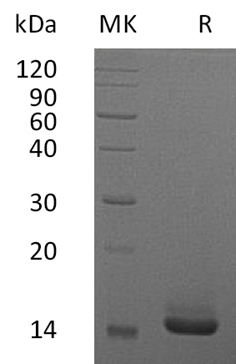#C003, Recombinant Human GM-CSF
Recombinant Human Granulocyte-Macrophage Colony-Stimulating Factor is produced by our E.coli expression system and the target gene encoding Ala18-Glu144 is expressed.
- Accession: P04141
- Known As: Granulocyte-Macrophage Colony-Stimulating Factor; GM-CSF; Colony-Stimulating Factor; CSF; Molgramostin; Sargramostim; CSF2; GMCSF
- Mol Mass: 14.6 KDa
- APMol Mass: 13-17 KDa
- Formulation Description: Lyophilized from a 0.2 μm filtered solution of PBS, pH 7.4.
- Endotoxin: Less than 0.001 ng/µg (0.01 EU/µg) as determined by LAL test.
- Purity

- Reconstitution
Always centrifuge tubes before opening. Do not mix by vortex or pipetting.
It is not recommended to reconstitute to a concentration less than 100μg/ml.
Dissolve the lyophilized protein in distilled water.
Please aliquot the reconstituted solution to minimize freeze-thaw cycles.
- Storage
Lyophilized protein should be stored at < -20°C, though stable at room temperature for 3 weeks.
Reconstituted protein solution can be stored at 4-7°C for 2-7 days.
Aliquots of reconstituted samples are stable at < -20°C for 3 months.
- Shipping
Upon receipt, store it immediately at the temperature listed below.
- Background
Granulocyte-Macrophage Colony Stimulating Factor (GM-CSF) was initially characterized as a growth factor that can support the in vitro colony formation of granulocyte-macrophage progenitors. It is produced by a number of different cell types (including activated T cells, B cells, macrophages, mast cells, endothelial cells and fibroblasts) in response to cytokine of immune and inflammatory stimuli. Besides granulocyte-macrophage progenitors, GM-CSF is also a growth factor for erythroid, megakaryocyte and eosinophil progenitors. On mature hematopoietic, monocytes/ macrophages and eosinophils. GM-CSF has a functional role on non-hematopoitic cells. It can induce human endothelial cells to migrate and proliferate. Additionally, GM-CSF can also stimulate the proliferation of a number of tumor cell lines, including osteogenic sarcoma, carcinoma and adenocarcinoma cell lines.

